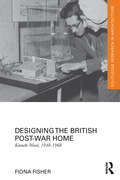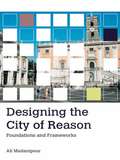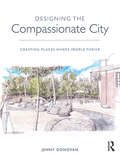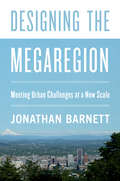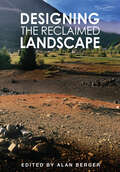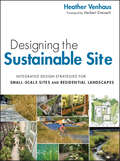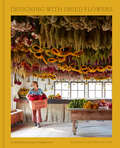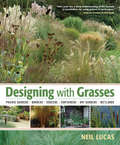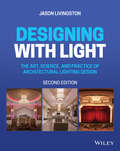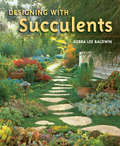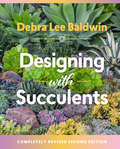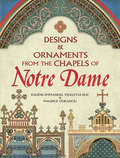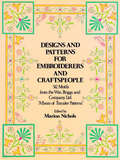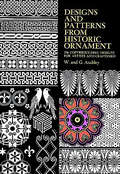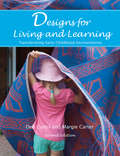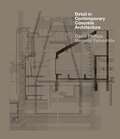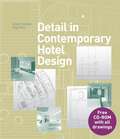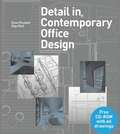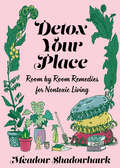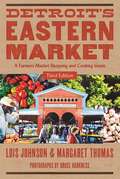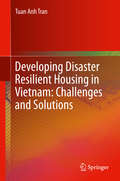- Table View
- List View
Designing for Play (Design and the Built Environment)
by Barbara E. HendricksArchitects, landscape designers, builders, gardeners and teachers have all at some time been called upon to design a play area. Unfortunately, this diversity has not resulted in a similar diversity of design solutions for this very problematic task. Despite a proliferation of 'how to' books on this subject, playgrounds have remained virtually the same throughout the world since their creation over a century ago. This is not a 'how to' design book. Instead, based on thirty years' experience as a specialist play area designer, Barbara Hendricks details a radically new approach, applying cutting-edge thinking from child development and child psychology to find innovative design solutions, challenging the established notions of play provision. Covering key sociological, public policy, environmental and design issues, this book provides designers with an exploration of and guide to, designing from a 'child's eye' view of the world. Beautifully crafted and copiously illustrated with numerous examples of recently designed playgrounds, this book is not only stimulating and informative, but fun to read and seriously playful in itself. This second edition brings the text up to date from 2001 to 2010 with added discussion about new ideas for play area designs and what has not worked in the past decade.
Designing the British Post-War Home: Kenneth Wood, 1948-1968 (Routledge Research in Architecture)
by Fiona FisherIn Designing the British Post-War Home Fiona Fisher explores the development of modern domestic architecture in Britain through a detailed study of the work of the successful Surrey-based architectural practice of Kenneth Wood. Wood’s firm is representative of a geographically distinct category of post-war architectural and design practice - that of the small private practice that flourished in Britain’s expanding suburbs after the removal of wartime building restrictions. Such firms, which played an important role in the development of British domestic design, are currently under-represented within architectural histories of the period. <P><P> The private house represents an important site in which new spatial, material and aesthetic parameters for modern living were defined after the Second World War. Within a British context, the architect-designed private house remained an important ‘vehicle for the investigation of architectural ideas’ by second generation modernist architects and designers. <P><P> Through a series of case study houses, designed by Wood’s firm, the book reconsiders the progress of modern domestic architecture in Britain and demonstrates the ways in which architectural discourse and practice intersected with the experience, performance and representation of domestic modernity in post-war Britain.
Designing the City of Reason: Foundations and Frameworks
by Ali MadanipourWith a practical approach to theory, Designing the City of Reason offers new perspectives on how differing belief systems and philosophical approaches impact on city design and development, exploring how this has changed before, during and after the impact of modernism in all its rationalism. Looking at the connections between abstract ideas and material realities, this book provides a social and historical account of ideas which have emerged out of the particular concerns and cultural contexts and which inform the ways we live. By considering the changing foundations for belief and action, and their impact on urban form, it follows the history and development of city design in close conjunction with the growth of rationalist philosophy. Building on these foundations, it goes on to focus on the implications of this for urban development, exploring how public infrastructures of meaning are constructed and articulated through the dimensions of time, space, meaning, value and action. With its wide-ranging subject matter and distinctive blend of theory and practice, this book furthers the scope and range of urban design by asking new questions about the cities we live in and the values and symbols which we assign to them.
Designing the Compassionate City: Creating Places Where People Thrive
by Jenny DonovanDesigning the Compassionate City outlines an approach to urban design that is centred on an explicit recognition of the inherent dignity of all people. It suggests that whether we thrive or decline—as individuals or as a community—is dependent on our ability to fulfil the full spectrum of our needs. This book considers how our surroundings help or hinder us from meeting these needs by influencing both what we can do and what we want to do; either inspiring us to lead healthy, fulfilled lives or consigning us to diminished lives tainted by ill health and unfulfilled potential. Designing the Compassionate City looks at how those who participate in designing towns and cities can collaborate with those who live in them to create places that help people to accumulate the life lessons, experiences and achievements, as well as forge the connections to meet their needs, to thrive and to fulfil their potential. The book explores a number of inspiring case studies that have sought to meet this challenge and examines what has worked and what hasn’t. From this, some conclusions are drawn about how we can all participate in creating places that leave a lasting legacy of empowerment and commitment to nurturing one another. It is essential reading for students and practitioners designing happier, healthier places.
Designing the Megaregion: Meeting Urban Challenges at a New Scale
by Jonathan BarnettAs the US population grows—potentially adding more than 110 million people by 2050—cities and their suburbs will continue expanding, eventually meeting the suburbs of neighboring cities and forming continuous urban megaregions. There are now at least a dozen megaregions in the US, such as the one extending from Richmond, Virginia, to Portland, Maine, and the megaregion that runs from Santa Barbara through Los Angeles and San Diego, down to the Mexican border. In Designing the Megaregion, planning and urban design expert Jonathan Barnett takes a fresh look at designing megaregions. Barnett argues that planning megaregions requires ecological literacy and a renewed commitment to social equity in order to address the increasing pressure this growth puts on natural, built, and human resources. If current trends continue, new construction in megaregions will put additional stress on natural resources, make highway gridlock and airline delays much worse, and cause each region to become more separate and unequal. Barnett offers an incremental approach to designing at the megaregional scale that will help prepare for future economic and population growth. Designing the Megaregion explains how we can, and should, redesign megaregional growth using mostly private investment, without having to wait for large-scale, government initiatives and trying to create whole new governmental structures. Barnett explains practical initiatives for adapting development in response to a changing climate, improving transportation systems, and redirecting the forces that make megaregions very unequal places. There is an urgent need to begin designing megaregions, and Barnett offers a hopeful way forward using systems that are already in place.
Designing the Reclaimed Landscape
by Alan BergerThe first practical yet in-depth exploration of how to reclaim the post-industrial landscape, this volume includes excellent case studies by practitioners and policy makers from around the US, giving first rate practical examples. The book addresses new thinking about landscape, which applies new techniques to the task of transforming outdated and disused post-extraction landscapes through design. In the USA alone, there are nearly 500,000 abandoned mines in need of reclamation and this book provides the first in-depth guidance on this real and pressing issue. Drawing on the work of the well-known Project for Reclamation Excellence at Harvard's Graduate School of Design, this volume outlines the latest design thinking, theory and practice for landscape planners, landscape architects and designers and others interested in maximizing the future potential of reclaimed land.
Designing the Sustainable Site
by Heather VenhausThe full-color, practical guide to designing sustainable residential landscapes and small-scale sites "Going green" is no longer a choice; it's a necessity. Developed landscapes have played a significant role in exacerbating the environmental and social problems that threaten humanity; however, they can also be part of the solution. Designing the Sustainable Site: Integrated Design Strategies for Small-Scale Sites and Residential Landscapes gives site designers and landscape architects the tools and information they need to become a driving force in the quest for sustainability. Advocating a regenerative design approach in which built landscapes sustain and restore vital ecological functions, this book guides readers through a design process for new and redeveloped sites that not only minimizes damage to the environment but also actively helps to repair it. Designing the Sustainable Site: Assists designers in identifying and incorporating sustainable practices that have the greatest positive impact on both the project and the surrounding community, within a regional context Uses photographs, sketches, and case studies to provide a comprehensive look at successful green landscape design Illustrates how sustainable practices are relevant and applicable to projects of any size or budget Demonstrates how built environments can protect and restore ecosystem services Explains the multiple and far-reaching benefits that sustainable design solutions can provide Assists project teams in fulfilling credit requirements of green building assessment tools, such as LEED, BREEAM, or SITES With attention to six global environmental challenges-including air pollution, urban flooding and water pollution, water shortages, invasive species, and loss of biodiversity-along with guidance on how to meet these challenges, Designing the Sustainable Site is a practical design manual for sustainable alternatives to small-scale site and residential landscape design.
Designing with Dried Flowers: Creating Everlasting Arrangements
by Hannah Rose MullerStep into the world of beautiful, everlasting flowers with this book of thirty-two dried flower arrangements that can be made all year round.Flowers are often fleetingly lovely, but a dried bouquet is a gift that can last. In Designing with Dried Flowers, you&’ll find small arrangements for every day, beautiful wreaths for every season and occasion, and celebration showstoppers that will look gorgeous in the moment and for months to come. Farmer-florist Hannah Muller of The Wreath Room at Full Belly Farm shares her unique methods to naturally dry flowers that hold their color and delicacy. Alongside the arrangements you&’ll learn how to dry your own flowers, whether they&’re from the supermarket or your garden. From there, create one of the many unique arrangements in the book, and easily create new ones with the same flowers. With step-by-step instructions for every arrangement, gorgeous photography to inspire your creations, and helpful information along the way, Designing with Dried Flowers is a must-have for every flower lover.
Designing with Grasses
by Neil LucasDesigning with Grasses shows gardeners not just what grasses are available, but how to design with grasses in different settings, including meadows, lawns, green roofs, and more. Design ideas are supported by carefully devised maintenance techniques, design checklists that make designing achievable by gardeners of all ability levels, and lists of grasses best for a variety of situations, including low-maintenance, drought-tolerant alternatives to the traditional lawn grasses and grasses suitable for green roofs and erosion control. An encyclopedic A to Z of grasses includes profiles with information on growth and care.
Designing with Light: The Art, Science, and Practice of Architectural Lighting Design
by Jason LivingstonThe new edition of the popular introduction to architectural lighting design, covering all stages of the lighting design process Designing with Light: The Art, Science, and Practice of Architectural Lighting Design, Second Edition, provides students and professionals alike with comprehensive understanding of the use of lighting to define and enhance a space. This accessible, highly practical textbook covers topics such as the art and science of color, color rendering and appearance, lighting control systems, building codes and standards, and sustainability and energy conservation. Throughout the text, accomplished lighting designer and instructor Jason Livingston offers expert insights on the use of color, the interaction between light and materials, the relation between light, vision, and psychology, and more. Fully revised and updated throughout, the second edition features new chapters on design thinking, common lighting techniques, and lighting economics. Expanded sections on aesthetics, controlling LEDs, light, and health, designing with light, and color mixing luminaires are supported by new case studies, examples, and exercises. Featuring hundreds of high-quality color images and illustrations, Designing with Light: Provides systematic guidance on all aspects of the lighting design process Thoroughly covers color and light, including color perception, color rendering, and designing with colored light Explains the theory behind the practice of architectural lighting design Contains information on cost estimating, life cycle analysis, voluntary energy programs, and professional lighting design credentials Includes an instructor resource site with PowerPoint presentations, test questions, and suggested assignments for each chapter, and also a student site with flashcards, self-evaluation tests, and helpful calculators. Designing with Light: The Art, Science, and Practice of Architectural Lighting Design, Second Edition is perfect for architecture, interior design, and electrical engineering programs that include courses on lighting design, as well as professionals looking for a thorough and up-to-date desk reference.
Designing with Succulents: 10th Anniversary Edition
by Debra Lee BaldwinLavishly illustrated with over 300 photographs, Designing with Succulents gives design and cultivation basics for paths, borders, slopes, and containers; hundreds of succulent plant recommendations; and descriptions of 90 easy-care, drought-tolerant companion plants. Beginners and experienced designers, landscapers, and collectors alike will find what they need to visualize, create, and nurture the three-dimensional work of art that is the succulent garden.
Designing with Succulents: Create A Lush Garden Of Waterwise Plants
by Debra Lee Baldwin“Designing with Succulents is inspiring, practical, and complete—a treasure for any gardener who loves these otherworldly beauties.” —Kathleen N. Brenzel, Sunset Succulents offer dazzling possibilities and require only minimal maintenance and very little water to remain lush and alluring year-round. No one knows them better than the Queen of Succulents, Debra Lee Baldwin. This new, completely revised second edition of her bestselling classic is a design compendium that is as practical as it is inspirational. Designing with Succulents shares design and cultivation basics; hundreds of succulent plant recommendations; and profiles of 50 easy-care, drought-tolerant companion plants. Lavishly illustrated with 400 photographs, you will find everything you need to visualize, create, and nurture a thriving, water-smart succulent garden.
Designology: How to Find Your PlaceType & Align Your Life with Design
by Dr. Sally AugustinA simple guide to creating spaces at home and work that align with your personality type and support your goals—with the help of science. Discover a new paradigm: Are you an adventurer or a visionary? A maverick or a maven? Designology makes design personal through environmental and design psychologist Sally Augustin&’s 8 personality &“Placetypes&” that characterize the different ways we can relate to the space around us.Personalize everything: What color should you paint your child&’s bedroom? How do shapes and patterns influence how you think in a space? How do room dimensions influence you psychologically? Designology answers all these questions and more with practical how-to advice and real-world examples sure to help make your house a happier place to be.Move forward with your design projects: Bust through the design paralysis that affects so many by applying verified science-based insights. Designology will help you regain control of your design-related efforts with suggestions customized to your personality and space-related needs.Find out what really matters: Designology teaches you how smells, textures, and other factors in your home influence your happiness. It shows you how your personality and ideal design styles are really related. Readers will learn about:· How to sound-scape a place whether they need to concentrate or think creatively· How to use scents in their home to help their family feel healthier· What to read into their spouse&’s desktop landscape· How to use paint to make their living room feel more comfortable· And much more!Take on your intimidating design tasks with confidence using this practical, personalizable how-to guide.
Designs and Ornaments from the Chapels of Notre Dame (Dover Pictorial Archive Ser.)
by Eugene-Emmanuel Viollet-le-Duc Maurice OuradouArchitect and theorist Eugene-Emmanuel Viollet-le-Duc (1814–79), a prominent leader in the French Gothic Revival, was active in the restoration of medieval buildings. In 1845 he undertook one of the greatest projects in the history of restoration: the cleansing and restoration of the Cathedral of Notre-Dame in Paris. For the next twenty-three years he labored at his task, returning the cathedral to its original beauty and charm.This volume is based on a faithful reproduction of the restored mural paintings of the chapels, notable for their originality of design and the soft and subtle harmony of their coloring. The 60 full-page plates lend themselves to numerous graphic arts applications.
Designs and Patterns for Embroiderers and Craftspeople
by Marion Nichols William Briggs Co.Have you ever wanted to create your own embroidery and crewel designs but given up the idea just because you can't draw? Here is a book containing over 500 patterns and designs from the finest Victorian source. Just transfer the designs to cloth, select a color scheme, use your favorite stitches, and soon your very own personal "noodle painting" will begin to form.These designs are classified according to type so that they are easier for you to use. You will find large motifs for big areas and dainty motifs for smaller projects; borders (narrow, medium, and wide) for pillows, sheets, and anything wanting a decorative edge; centers and corners for tablecloths and upholstery; insects, birds, and flowers for adding color to shirts and jeans; and even scenes perfect for sewing and framing.A wide variety of flowers, sprays, and greenery is included in this book, usually in various combinations: daisies, tulips, peonies, dahlias, cornflowers, lilies, rosebuds, poppies, violets, and forget-me-nots, plus shamrocks, heather, and flowers with ribbons, in baskets, etc. There are also butterflies, bluebirds, bumblebees, owls, dragonflies, and insects of all sorts. For those whose tastes are more unconventional or avant-garde, there are geometric designs, dramatic sunbursts, and unusual beasts.Complete instructions explain how to transfer these designs to cloth, and imaginative crafters will find this book suitable to a variety of other media, including metalwork, woodwork leather craft, and more.
Designs and Patterns from Historic Ornament (Dover Pictorial Archive)
by W. And AudsleyThis well-known book was prepared a century ago by two British architects, and its reputation has grown steadily since. The Audsleys' rendering of designs from a wide variety of sources are national traditions, and their excellent sense of space and proportion and their straightforward interpretations of these ornaments have made this collection among the most valuable of its kind.The 60 plates contain over 250 large-scale line drawings, mostly executed by the authors. The designs and patterns shown are derived from architectural decorative motifs, textile designs, patterns from ceramics, etc. A brief text specifies sources for many of the designs, and captions identify national origin and often the original color schemes.The illustrations include ancient Egyptian patterns from painted tomb ceilings, borders from Greek vases, Celtic designs, Japanese ornaments, Moorish decorations, eleventh-century Italian textile designs, and architectural elements from the cathedral of Notre-Dame and other buildings.This partial list of contents gives an idea of the many styles of design reproduced in the book, and the applications to which the designs can be put. Commercial artists, architects, crafters, designers, scene designers, and others will find these pages a rich source of decorative designs.
Designs for Living and Learning, Second Edition
by Deb Curtis Margie CarterYou likely have dreams for your early childhood environment that are greater than rating scales, regulations, and room arrangements. Designs for Living and Learning has been a favorite resource among educators and caregivers for more than a decade, and this new edition is packed with even more ideas that can be used as you create captivating environments that nurture children, families, and staff while supporting children's learning. With hundreds of all-new colorful photographs of real early learning settings and a multitude of simple and practical concepts for creative indoor and outdoor spaces and learning materials, this book truly is a source of inspiration as you learn how to shape welcoming spaces where children can learn and grow.Expanded chapters include new information reflecting current trends and concerns in early childhood, such as the use of repurposed and nontraditional materials, children in the outdoors, alternative ways to think about providing for learning outcomes, facing and overcoming barriers and negotiating change, and the impact of environmental rating scales in Quality Rating and Improvement Systems (QRIS). Two new chapters are included, one highlighting the transformations of environments with before and after photos and outlines of the process, and the other with examples of soliciting children's ideas about the environment.Deb Curtis and Margie Carter are internationally acclaimed experts in early childhood. They host three-day institutes and professional development seminars for early childhood professionals; consult with early childhood programs across North America, Australia, and New Zealand; and have written many books together.
Detail in Contemporary Concrete Architecture (Detail)
by David Phillips Megumi YamashitaDetail in Contemporary Concrete Architecture provides analysis of both the technical and the aesthetic importance of details in modern concrete architecture. Featuring the work of renowned architects from around the world, this book presents 49 of the most recently completed and influential concrete designs for both residential and commercial architecture.The projects are presented in clear and concise layouts over four pages. All of the drawings are styled consistently and presented at standard architectural scales to allow for easy comparison. Each project is presented with colour photographs, site plans and sections and elevations, as well as numerous construction details. There is also descriptive text, detailed captions and in-depth information for each project. A bonus CD-ROM contains drawings from the book, in both EPS and DWG (generic CAD) formats.
Detail in Contemporary Hotel Design
by Drew PlunkettHotel interiors need to satisfy the imaginations of their customers and whet the appetite for a return visit or recommendation, and the design that gets the formula right will do as much to prolong the life of the business as the service delivered within the hotel. This book explores in detail 36 of the best recent hotel interior design schemes, featuring projects by leading architects from around the world. The book is divided into three sections embracing newly built and refurbished hotels as well as conversions.Each project includes photographs as well as detailed drawings and plans, where appropriate, as well as informative text describing the design concept and process. A bonus CD contains drawings featured in the book, in both eps and dwg (generic CAD) formats.
Detail in Contemporary Hotel Design (Detailing for Interior Design)
by Drew Plunkett Olga ReidHotel interiors need to satisfy the imaginations of their customers and whet the appetite for a return visit or recommendation, and the design that gets the formula right will do as much to prolong the life of the business as the service delivered within the hotel. This book explores in detail 36 of the best recent hotel interior design schemes, featuring projects by leading architects from around the world. The book is divided into three sections embracing newly built and refurbished hotels as well as conversions.Each project includes photographs as well as detailed drawings and plans, where appropriate, as well as informative text describing the design concept and process. A bonus CD contains drawings featured in the book, in both eps and dwg (generic CAD) formats.
Detail in Contemporary Office Design
by Drew PlunkettOffice design has changed significantly over the last few years and is now one of the most innovative areas of interior design. It used to be the case that only the public spaces of an office were creatively designed, but increasingly the staff areas are seen as key reflections of the company brand as well. In more radical offices, there is also a growing belief in the importance of work areas as social spaces and a blurring of the distinction between work and recreation.This book explores in detail 42 of the best recent office design schemes, featuring projects from leading architects around the world. Each project includes photographs as well as detailed drawings and plans, where appropriate, in addition to informative text describing the design concept and process. A bonus CD contains drawings featured in the book, in both eps and dwg (generic CAD) formats.
Detail in Contemporary Office Design (Detailing for Interior Design)
by Drew Plunkett Olga ReidOffice design has changed significantly over the last few years and is now one of the most innovative areas of interior design. It used to be the case that only the public spaces of an office were creatively designed, but increasingly the staff areas are seen as key reflections of the company brand as well. In more radical offices, there is also a growing belief in the importance of work areas as social spaces and a blurring of the distinction between work and recreation.This book explores in detail 42 of the best recent office design schemes, featuring projects from leading architects around the world. Each project includes photographs as well as detailed drawings and plans, where appropriate, in addition to informative text describing the design concept and process. A bonus CD contains drawings featured in the book, in both eps and dwg (generic CAD) formats.
Detox Your Place: Room by Room Remedies for Nontoxic Living
by Meadow ShadowhawkLooking to detox your home without the use of harsh chemicals, overly processed cleaning products, or by any other questionable means? Meadow Shadowhawk will help you through the process, with well-researched advice about topics like making your own cleaning products, selecting paint, choosing a vacuum cleaner, and even replacing furniture and insulation. Includes recipes for creating your own versions of everyday items, tips on what to buy (and what to avoid!), and what the facts are about various things. This book is a guide to overhauling your home to make it safer and more comfortable for yourself, your family, and your pets. Here's to living a happier, healthier life!
Detroit's Eastern Market: A Farmers Market Shopping and Cooking Guide, Third Edition (Painted Turtle)
by Bruce Harkness Lois Johnson Margaret ThomasSince 1887, Detroit’s Eastern Market, the largest open-air market of its kind in the United States, has been home to an amazing community of farmers, merchants, and food lovers. Specialty shops, bakeries, spice companies, meat and poultry markets, restaurants, jazz cafés, old-time saloons, produce firms, gourmet shops, and cold-storage warehouses cover Eastern Market’s three square miles. Its many streets and vendors reflect the varied cultures and ethnicities that have shaped the city of Detroit. In this third edition of Detroit’s Eastern Market, authors Lois Johnson and Margaret Thomas recount the history of the market with additional stories and personal accounts of families who have worked and shopped there for as many as four generations. The authors have updated store information and added new restaurants and businesses to their original listings, reflecting the changes and additions that have taken place in Eastern Market since the previous edition in 2005. Richly illustrated with all new photos, Detroit’s Eastern Market features more than a hundred pages of delightful recipes (including 17 new ones) from market retailers, farmers, chefs, and customers.
Developing Disaster Resilient Housing in Vietnam: Challenges and Solutions
by Tuan Anh TranThis book provides a comprehensive understanding on disaster resilient housing within the Vietnam context particularly and the developing world generally. The book has identified the root causes of housing vulnerability, restrictions to safe housing development, concepts of disaster resilient housing, key issues/factors implementers and building designers need to consider, and ways of achieving resilient housing outcomes in actual design projects. The design and development of disaster resilient housing has been framed into three main themes: (i) community consultation, (ii) the role of built-environment professionals and (iii) design responses for resilience. To achieve these themes, there is a variety of contextual and intervening conditions that need to be addressed and met to provide an enabling environment for promoting disaster resilient housing. These three themes are among the most arguable issues in recent debates and discussions, academically and practically, regarding disaster risk reduction and safe housing development. In addition, this book also provides the evidence-based design framework for disaster resilient housing upon which design ideas and solutions for safe and resilient housing can be generated and shaped.

